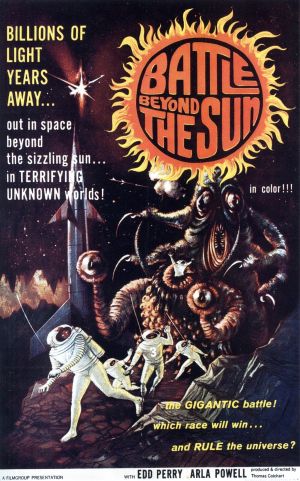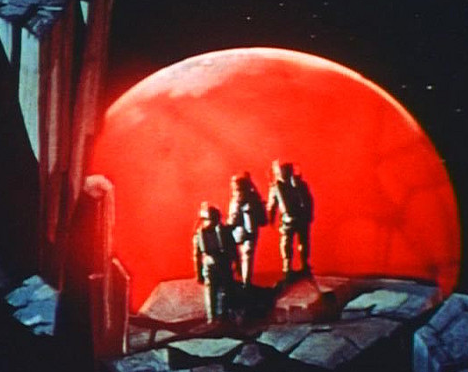‘No battle and little sun, but two for the endurance of one.’ That is the tag line that applies to this 1hr 17 minutes exercise. On the IMDB it is titled ‘The Sky Calls’ (1959) yet the art work proclaims the title ‘Battle Beyond the Sun.’ Go figure.

It was made in the Soviet Union a short while after the launch of the first Terra satellite, Sputnik, in October 1957 as the threshold of space flight was crossed. In some shots it shows something of Star City where the Soviet space program developed and the displays of weightlessness are good. These effects are several cuts above the norm at the time. However the space flight effects are at the norm, e.g., flames in the void of space.
Two for one? There is the original Soviet version and another. In the first version the Soviets with rockets clearly marked CCCP have an orbiting space station devoted to celestial science and are methodically preparing a peace-loving mission to Mars. Then out of the void a US rocket calls for permission to dock and repair engines. The Soviets graciously agree. Though the interaction is constrained, the sneaky Americans learn that the Soviets are Mars-bound.
The Americans rush back to their ship and blast off for Mars in the hope of getting there first and claiming all the Mars Bars for Yankeeland. In the haste, the back draft of their rocket injures a hapless Soviet crewmen star-bathing on the deck of the space station. He is long suffering and very forgiving.
In due course the Soviets take off for Mars and no sooner do they do so than the impetuous Americans run into trouble and SOS to the Soviets, who divert from the Mars course to rescue them, and in so doing they expend most of the fuel. Gulp!
Both crews are only two man, one a retiree and the other younger, both clad in polyester knits. Remember those? If not, lucky you.
Both rockets were built for a two-man crew, right, but somehow the two American passengers squeeze on board into the micro-economy seats. The Soviets decide to land on a convenient asteroid and send for road side assistance. They borrow a dime from ET and call home. An automatic, pilotless fuel tanker is dispatched to the asteroid. It is no recommendation for Tesla self-driving cars that the fuel tanker crashes into the far side of asteroid. Gulp!
It seems the asteroid is too hard to hit for a computer so a second pilotless fuel tanker rocket is sent with a volunteer pilot. How he squeezed in is left to the imagination. The fraternity brothers imagined the worst.
He pilots the rocket to the asteroid and lands. The stranded spacemen do not seem to notice, so busy are they in trading clichés about cooperation and peace. Zzzzzzzzzzzz.
The tanker pilot of the once-pilotless ship becomes sick from radiation poisoning since the pilotless fuel tank rocket had no shielding to protect the pilot. Did anyone tell him? Is there workers compensation? What are the KPIs here? Did the manager manage? The sick pilot roams around the asteroid and dies. The maroonies find the dead man and realise he came by rocket. They are scientists after all and they can make inferences. Zounds! They tank up and blast off for Terra to carry the clichés back. The end. Then the dreamer awakes and it was all a dream. The double end.
Wait! There is more!
Roger Corman bought the film and edited it for the US market in 1962. He hired a destitute film school student to do the work and credited him as associate producer, that was Francis Ford Coppola’s first on-screen credit. He took liberties in the Corman manner.
All references to the the CCCP and the USA are obliterated by kindergarten finger-painted blobs of colour. A voice over prologue says the following story takes places after an atomic war and it is a race to Mars between the Northern Hemisphere and the Southern Hemisphere, the two Orwellian blocs that emerged from the rubles. (Joke.) The dialogue was cleansed of the anti-American references or mentions of the Soviet Union. The dubbing is as annoying as it usually is. The nylon double knits remain, as do the geriatric Soviet actors who move with glacial speed. It is set in 1997 and, despite the insertions, is shorter than the ponderous Soviet original. Mercy be. It remains ponderous.
Knowing the market, Coppola also exercised artistic license to insert a scene on the asteroid while the dying tanker pilot wanders around, in which scene he observes two proto-CGI creatures fighting each other. This scene qualified the movie to go on a double-bill of creature features, and the fight has nothing to do with the story and is never mentioned by any of the survivors. Accordingly they do not warn future travellers not to stop there. They bad. Thus launched was FFC’s film career.
In the end, the rocketeers watch red Mars in the near distance as they blast off for home.

Yes, they have their clichés safely on board. This is no dream.
But to watch it is to see, Braque-style, two movies in one. The original Soviet snooze and the Corman mash-up.
